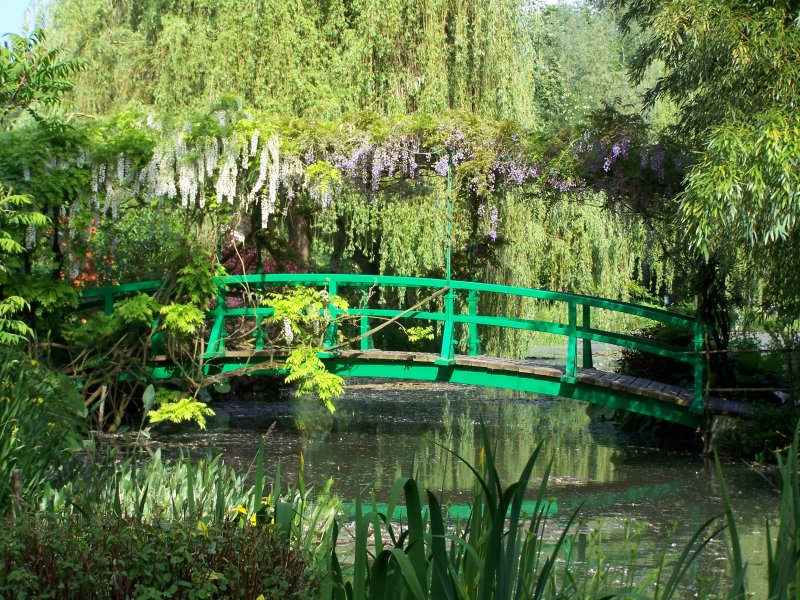Claude Monet's Home in Giverny
Texts and Photos
by Ariane Cauderlier, guide interpreter
Watercolors by Patricia Rynski
d'Argence, guide interpreter
 En
Francais : La Maison de
Claude Monet à Giverny
En
Francais : La Maison de
Claude Monet à Giverny
WARNING
Claude Monet's Home and Gardens are now open since April 1st,
2023.
They
will stay open until November 1st, 2023.
Please refer to Monet's garden page for even more information
-------------------------------------
and are therefore museum pieces.
Please don't touch any piece of furniture nor any object.
2023 Admission Tickets:
- Admission Tickets can be purchased online.
- Online SeeTickets rates:
- Normal fare & seniors: 12.00 euros
- Children under 7yo: free of charge
- Children & students: 7.50 euros
- Disabled people: 6.50 euros
- Management fees: 1.45 euros per folder
- All tickets include admission to The House and The Gardens
Guided Tours:
Visitor Information:

 Bus
/ Minibus Day Trip Tours from Paris
Bus
/ Minibus Day Trip Tours from Paris
 Hotels, Bed and
Breakfast in Giverny area
Hotels, Bed and
Breakfast in Giverny area
Further readings:
 An
introduction to Claude Monet's Garden
An
introduction to Claude Monet's Garden

Hotel, Palace or Farm ?
Do as Claude Monet:
Select Giverny area for your next Stay in Paris !
A very long house
Claude Monet lived in his home at Giverny for forty-three years,from 1883 to 1926. During this very long time, he layed out the house to his own tastes, adapting it to the needs of his family and professional life.
At the beginning, the house called House of the Cider-Press (an apple-press located on the little square nearby gave its name to the quarter) was much smaller. Monet enlarged it on both sides. The house is now 40 meter long per 5 meter deep only.
The barn next to the house became his first studio, thanks to the addition of a wooden floor and of stairs leading to the main house. Monet, who mostly painted in the open air, needed a place where to store and finish his canvases.
Above the studio, Monet had his own apartment, a large bedroom and a bathroom. The left side of the house was his side, where he could work and sleep.
The family home of a well off painter
The two wings added by Monet can be noticed thanks to the size of the windows: the new ones are broader than the windows of the central part of the building.
At the other end of the house, Monet designed a large kitchen, suitable to prepare the meals of a ten people family that entertained a lot.
Over the kitchen, Monet's four step-daughters had their bedrooms, while his two sons and his two step-sons slept in the attic.
The pink color of the walls and the green of the shutters was chosen by Monet. In those times, shutters were tradionally painted grey. Monet added a gallery in front of the house, a pergola covered with climbing roses, and grew a virginia creeper on the facade: he wanted the house to blend with the garden.
The house has three entrances. The left one leads to Monet's apartment, the middle one is the main entrance, the right one is for domestic use and leads to the kitchen.

Monet's home, photo Ariane Cauderlier

The blue sitting room, photo Ariane Cauderlier
The blue sitting room
The tour of the house starts with the little sitting-room where Alice Hoschedé-Monet sat with the children.
Monet, who loved colors, chose all the colors in the house.
The stunning blues of the sitting-room, on the walls and on the furniture, harmonise with the japanese woodblocks that Monet collected passionately for fifty years. The painter owned 231 of them. He liked seeing them around, they inspired him very much.
On the floor, cement tiles were very trendy at Monet's times.

Detail of the floor of the blue sitting room,
watercolor by Patricia Rynski d'Argence

The pantry in Monet's house at Giverny,
photo Ariane Cauderlier
The pantry
The next room is Monet's entrance, fitted out into a small pantry.
It was not heated, thus enabled to store food, especially eggs and tea. Lots of eggs were eaten. They were layed by the hens of the chicken yard. The two boxes hanging on the walls could store 116 eggs!
The furniture in bamboo style are typical for the Japonism fashion of the times. The buffet has got keys, even on the drawers. Food was expensive and locked down.

The egg box
watercolor by Patricia Rynski d'Argence
The first studio of Claude Monet
From the pantry, one goes to Monet's first studio, that later became his smoking room where the painter welcomed his visitors, art dealers, critics, collectors...

The first studio of Monet, photo Ariane Cauderlier
On the walls, reproductions of Monet's works evocate the atmosphere of the place at Monet's times. The painter liked to keep a record of each step of his career. Many of the originals that were kept in this room are now to be seen at Musée Marmottan-Monet in Paris.
Like everywhere in the house, the furniture and the objects are still exactly the same, what gives a great authenticity to Monet's home.
A bust of Claude Monet by Paul Paulin reminds that the leader of impressionism became famous during his lifetime, although he had to wait until he was fifty before he was eventually recognized as a master.

In Giverny Monet's studio,
Watercolor by Patricia Rynski d'Argence

Claude Monet's bedroom, photo Ariane Cauderlier
Claude Monet's bedroom
A very steep staircase leads from the pantry to the upper floor.
One first enters Claude Monet's bedroom. Monet slept in this very simple bed, and died there the 5th December 1926.
The painter had gorgeous views on the garden out of the three windows.
The delicately adornated desk and the commode date back to the 18th Century.
Paintings by artists of the colony of Giverny hang on the walls. Monet exhibited in his room impressionist works by his friends: Cézanne, Renoir, Pissarro, Sisley, Morisot, Boudin, Manet, Signac...

Main staircase of Giverny Monet's House,
watercolor by Patricia Rynski d'Argence

Alice Monet's bedroom, photo Ariane Cauderlier
Alice's bedroom
Claude and his wife Alice didn't share the same bedroom, as was usual in the middle upper class, but there was a connection through the bathrooms.
The very simple bedroom of Alice is decorated with japanese woodblocks featuring female characters.
It is one of the few rooms that have a window on the street side, that is to say to the north. One can see how narrow the house is. From her bedroom, Alice could keep an eye on the children on the other side of the landing.
At the top of the main staircase, a closet was used to store the linen.

Monet's washbasin
watercolor by Patricia Rynski d'Argence

Monet's dining-room, photo Ariane Cauderlier
The dining room
The main staircase leads to the dining room, the most dramatic room of the house.
Monet, who didn't care for fashion, which was very dark and heavy in Victorian times, had it painted in two tones of yellow. This vibrant color enhances the blues of the dishes on display in the buffets.
The walls are packed with japanese engravings that Monet chose with an expert eye. For fifty years, he collected the prints by the best japanese artists, especially Hokusai, Hiroshige and Utamaro.

Detail of the buffet,
watercolor by Patricia Rynski d'Argence

Monet's dining-room, photo Ariane Cauderlier
The kitchen
The dining room is connected to the kitchen to make service easier. Monet wanted a blue kitchen so that the guests would see the right color in harmony with the yellow dining room when the door to the kitchen was open.
The walls of the kitchen are covered with tiles of Rouen. The coolness of the blue contrasts with the warm glow of the extended collection of coppers. An enormous coal and wood stove kept the kitchen very warm year round.
The exit is by the kitchen stairs on to the garden.

Detail of the buffet,
watercolor by Patricia Rynski d'Argence
and are therefore museum pieces.
Please don't touch any piece of furniture nor any object.
Visitor Information:

 Bus
/ Minibus Day Trip Tours from Paris
Bus
/ Minibus Day Trip Tours from Paris
Further readings:
 An
introduction to Claude Monet's Garden
An
introduction to Claude Monet's Garden



